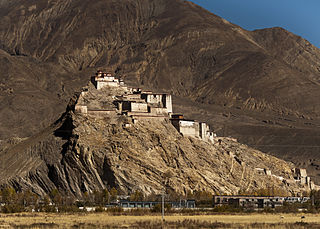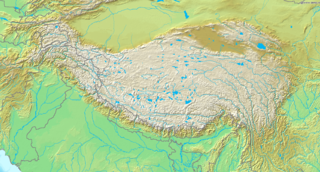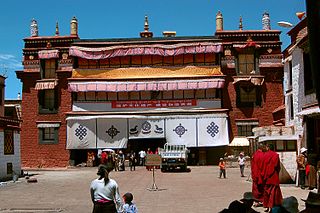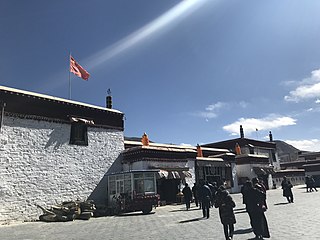 W
WThis is a list of the Major Historical and Cultural Sites Protected at the National Level in the autonomous region of Tibet, the People's Republic of China.
 W
WDrepung Monastery, located at the foot of Mount Gephel, is one of the "great three" Gelug university gompas (monasteries) of Tibet. The other two are Ganden Monastery and Sera Monastery.
 W
WGanden Monastery or Ganden Namgyeling or Monastery of Gahlden is one of the "great three" Gelug university monasteries of Tibet. It is in Dagzê County, Lhasa. The other two are Sera Monastery and Drepung Monastery. Ganden Monastery was founded in 1409 by Je Tsongkhapa Lozang-dragpa, founder of the Gelug order. The monastery was destroyed after 1959, but has since been partially rebuilt. Another monastery with the same name and tradition was established in Southern India in 1966 by Tibetan exiles.
 W
WGuge was an ancient dynastic kingdom in Western Tibet. The kingdom was centered in present-day Zanda County, Ngari Prefecture, Tibet Autonomous Region. At various points in history after the 10th century AD, the kingdom held sway over a vast area including south-eastern Zanskar, Upper Kinnaur district, and Spiti Valley, either by conquest or as tributaries. The ruins of the former capital of the Guge kingdom are located at Tsaparang in the Sutlej valley, not far from Mount Kailash and 1,200 miles (1,900 km) westwards from Lhasa.
 W
WGyantse Dzong or Gyantse Fortress is one of the best preserved dzongs in Tibet, perched high above the town of Gyantse on a huge spur of grey brown rock.
 W
WThe Jokhang, also known as the Qoikang Monastery, Jokang, Jokhang Temple, Jokhang Monastery and Zuglagkang, is a Buddhist temple in Barkhor Square in Lhasa, the capital city of Tibet. Tibetans, in general, consider this temple as the most sacred and important temple in Tibet. The temple is currently maintained by the Gelug school, but they accept worshipers from all sects of Buddhism. The temple's architectural style is a mixture of Indian vihara design, Tibetan and Nepalese design.
 W
WThe Karuo culture was a Neolithic culture in Tibet. The culture cultivated foxtail millet.
 W
WKhorzhak Monastery is a Buddhist monastery in Khorzhak town, Burang county, Ngari Prefecture in western Tibet. It is located not far to the southeast of Burang and just northeast of the Indian border. The town and temple are known as Kojanath in Hindi. The village is situated on a beautiful spot at a bend of the Karnali River from where one can see the large red wall of the temple facing the river with a huge inscription on it of the six-syllable mantra, OM MANI PADME HUM.
 W
WMindrolling Monastery, is one of the "Six Mother Monasteries" of the Nyingma school in Tibet. It was founded by Rigzin Terdak Lingpa in 1676. Tendrak Lingpa's lineage is known as the Nyo lineage. The name in Tibetan means "Place of Perfect Emancipation". It is located in Zhanang County, Shannan Prefecture, Tibet Autonomous Region, China, known as U-Tsang. Mindrolling Monastery is approximately 43 kilometers east of the Lhasa airport, on the south side of the Tsangpo river.
 W
WNorbulingka is a palace and surrounding park in Lhasa, Tibet, China, built from 1755. It served as the traditional summer residence of the successive Dalai Lamas from the 1780s up until the 14th Dalai Lama's exile in 1959. Part of the "Historic Ensemble of the Potala Palace", Norbulingka is recognized as a UNESCO World Heritage Site, and was added as an extension of this Historic Ensemble in 2001. It was built by the 7th Dalai Lama and served both as administrative centre and religious centre. It is a unique representation of Tibetan palace architecture.
 W
WThe Nyethang Drolma Temple is a temple in Nyêtang in the Tibet Autonomous Region of China dedicated to Tara. It is associated with Atiśa (980–1054), who founded the Kadam school of Tibetan Buddhism. The monastery survived the Cultural Revolution relatively undamaged. It is dedicated to Tara, a female bodhisattva, and contains many statues and paintings of Tara.
 W
WThe Palcho Monastery or Pelkor Chode Monastery or Shekar Gyantse is the main monastery in the Nyangchu river valley in Gyantse, Gyantse County, Shigatse Prefecture, Tibet Autonomous Region. The monastery precinct is a complex of structures which, apart from the Tsuklakhang Monastery, also includes its Kumbum, believed to be the largest such structure in Tibet, that is most notable for its 108 chapels in its several floors and the old Dzong or fort.
 W
WThe Potala Palace is a dzong fortress in the city of Lhasa, Tibet Autonomous Region, China. It was the winter palace of the Dalai Lamas from 1649 to 1959, has been a museum since then, and has been a World Heritage Site since 1994.
 W
WRamoche Temple is a Buddhist monastery in Lhasa, Tibet Autonomous Region. It dates back to the seventh century and is considered to be the most important temple in the city after the Jokhang Temple. Situated in the northwestern part of the Tibetan capital, it is east of the Potala and north of the Jokhang. The site occupies an area of 4,000 square meters.
 W
WSakya Monastery, also known as Pel Sakya is a Buddhist monastery situated 25 km southeast of a bridge which is about 127 km west of Shigatse on the road to Tingri in Tibet Autonomous Region.
 W
WSamye, full name Samye Mighur Lhundrub Tsula Khang and Shrine of Unchanging Spontaneous Presence is the first Tibetan Buddhist and Nyingma monastery built in Tibet, during the reign of King Trisong Deutsen. Shantarakshita began construction around 763, and Vajrayana founder Guru Padmasambhava tamed the local spirits for its completion in 779. The first Tibetan monks were ordained there. Samye was destroyed during the Cultural Revolution then rebuilt after 1988.
 W
WSera Monastery is one of the "great three" Gelug university monasteries of Tibet, located 1.25 miles (2.01 km) north of Lhasa and about 5 km (3.1 mi) north of the Jokhang. The other two are Ganden Monastery and Drepung Monastery. The origin of its name is attributed to a fact that during construction, the hill behind the monastery was covered with blooming wild roses.
 W
WShalu Monastery is small monastery 22 kilometres (14 mi) south of Shigatse in Tibet. Founded in 1040 by Chetsun Sherab Jungnay, for centuries it was renowned as a centre of scholarly learning and psychic training and its mural paintings were considered to be the most ancient and beautiful in Tibet. Shalu was the first of the major monasteries to be built by noble families of the Tsangpa during Tibet's great revival of Buddhism, and was an important center of the Sakya tradition.
 W
WTashi Lhunpo Monastery, founded in 1447 by the 1st Dalai Lama, is the traditional monastic seat of the Panchen Lama, and an historically and culturally important monastery in Shigatse, the second-largest city in Tibet.
 W
WTholing Monastery is the oldest monastery in the Ngari Prefecture of western Tibet. It is situated in Tholing (Zanda), Zanda County, near the Indian border of Ladakh. It was built in 997 AD by Yeshe-Ö, the second King of the Guge Kingdom. In Tibetan language 'Tholing' means "hovering in the sky forever" and is reflected by the location of the monastery at an elevation of 12,400 feet (3,800 m). The complex includes three temples, the Yeshe-O Temple, the Lhakhang Karpo and the Dukhang. There are many ancient, precious, and well-preserved frescoes.
 W
WTradruk Temple in the Yarlung Valley is the earliest great geomantic temple after the Jokhang and some sources say it predates that temple.
 W
WThe Valley of the Kings or Chongye Valley branches off the Yarlung Valley to the southwest and contains a series of graveyard tumuli, approximately 27 kilometres (17 mi) south of Tsetang, Tibet, near the town of Qonggyai on Mure Mountain in Qonggyai County of the Shannan Prefecture.